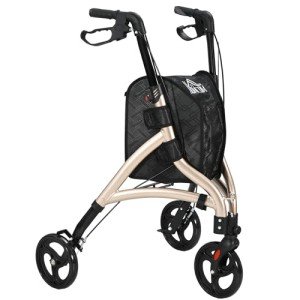
Lightweight Walker
FollowOverview
-
Founded Date 26 October 1962
-
Sectors BPO
-
Posted Jobs 0
-
Viewed 14
Company Description
10 Rollator With Storage Tricks All Experts Recommend
Rollator with Storage: A Comprehensive Guide for Independent Mobility
Rollators are mobility aids designed to assist people with walking troubles while promoting independence and safety. Unlike traditional walkers, rollators come equipped with wheels for simple and easy navigation, making them a vital tool for numerous elderly and disabled individuals. One of the essential functions that boost the functionality of rollators is storage. This post checks out rollators with incorporated storage choices, highlighting their benefits, types, and essential factors to consider when choosing the right model.
Comprehending Rollators
What is a Rollator?
A rollator is a wheeled walker that offers support for people who may have problem with balance or endurance. Normally, rollators are developed with the following features:
- Wheels: Rollators are equipped with either 2 or four wheels, enabling smooth maneuverability.
- Hand Brakes: Most have hand brakes for included safety, enabling users to control their speed.
- Seat: Many designs include an integrated seat, providing a resting point when required.
- Storage: Rollators often feature baskets or bags for bring individual items like water bottles, groceries, or medical materials.
Benefits of Using a Rollator with Storage
The addition of storage alternatives in rollators brings several benefits:
- Convenience: Users can easily transport personal valuables, decreasing the requirement for additional help.
- Self-reliance: Having access to necessary products while being mobile empowers individuals to maintain their independence in various environments, such as supermarket, parks, or homes.
- Safety: By safely saving products, users can more with confidence navigate their environments without the risk of dropping important goods.
- Convenience: Having a seat for resting allows users to take breaks when needed, further improving mobility.
Kinds of Rollators with Storage
Numerous kinds of rollators come equipped with storage services:
| Rollator Type | Description | Appropriate for |
|---|---|---|
| Requirement Rollator | Normally includes four wheels and a sturdy frame. Storage choices, like a built-in bag or basket, are frequently consisted of. | General use, outdoors |
| Compact Rollator | A smaller sized version that folds quickly for transportation. While these designs typically have limited storage, many still consist of minimal functionality. | Travelers and tight areas |
| Durable Rollator | Developed for larger people, these rollators often have much better storage capacity. | Bigger users, stability requires |
| Rollator with Seat | Features a built-in seat for resting. Storage alternatives differ, often including baskets or shopping bags. | Those requiring regular breaks |
| Walker-Carrier Combo | Serve as both a rollator and a lightweight cart, perfect for shopping trips. | Grocery shopping, outdoor use |
Choosing the Right Rollator with Storage
When selecting a rollator with storage, a number of aspects need to be thought about to guarantee that it meets private requirements.
Secret Features to Assess
- Weight Capacity: Always examine the weight limit of the rollator to make sure safety and functionality.
- Size and Foldability: Consider how the rollator suits your living space and whether it can be easily saved or carried.
- Storage Capacity: Assess the size and accessibility of storage compartments. Search for options that enable protected storage without frustrating the user with intricacy.
- Adjustable Handles: Ensure that the handles can be gotten used to the suitable height to enhance convenience and ergonomics.
- Braking System: A trustworthy braking system is necessary. Ensure the brakes are easy to engage and disengage.
- Wheel Size and Type: Larger wheels can navigate rougher terrain, while smaller ones might be preferable for flat surfaces.
Extra Considerations
- Devices: Many rollators have optional devices, such as cup holders or seat cushions, to boost user experience.
- Service warranty and Support: Investigate whether the producer provides a guarantee for defects or damages.
- User Reviews: Online customer reviews can offer valuable insights into efficiency and satisfaction.
Upkeep and Care of Rollators
To guarantee longevity and optimal performance, routine upkeep is essential. Users should think about the following practices:
- Regular Cleaning: Wipe down the frame and elements to avoid rust and preserve hygiene.
- Inspect Brakes: Ensure that the brakes are working appropriately and change them as needed.
- Check Wheels: Regularly look for any particles captured in the wheels or signs of wear and tear.
- Tighten Hardware: Periodically check and tighten up screws or bolts to keep safety.
Often Asked Questions (FAQs)
1. How do I pick the right size rollator for me?
Selecting the best size involves assessing your height and weight, in addition to monitoring handle height modifications to ensure that it is suitable for your stature.
2. Can I use a rollator on irregular surface?
Yes, some rollators are created with larger wheels and shock-absorbing systems that make them more appropriate for irregular terrain. It’s necessary to examine the requirements.
3. Is it simple to fold a rollator for transport?
Most modern rollators are developed to be easily foldable. Look for instructions in the user handbook that accompany your selected model.
4. Just how much weight can a normal rollator assistance?
The majority of standard rollators support between 250 to 350 pounds; however, sturdy designs can support higher weights.

5. Can I include accessories to my rollator?
Yes, many rollators come with the alternative of adding devices like cup holders, trays, and bags to enhance functionality.
In summary, a rollator with storage is an important mobility aid that empowers individuals while supplying them with the convenience of transporting necessary products. By understanding the various types, key functions, and maintenance requirements, users can with confidence select the best rollator that fits their lifestyle, promoting self-reliance and comfort in daily activities. As mobility aids continue to develop, they end up being progressively necessary for improving the lifestyle for elderly and disabled people.


